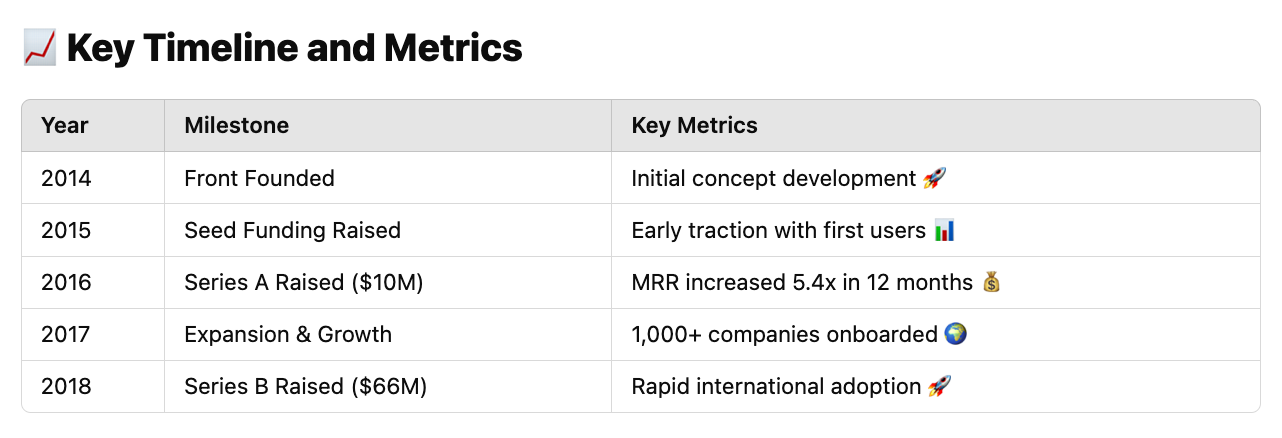In 2016, Front, a collaborative email platform, secured a 💰 $10 million Series A investment with a compelling pitch deck that effectively articulated the company's vision, traction, and market potential. The deck, publicly shared by CEO Mathilde Collin, offers invaluable lessons for startups seeking funding.
📌 Identifying the Problem
📧 Email remains a fundamental tool for business communication, yet its traditional design caters primarily to individual use. This limitation creates inefficiencies in team collaboration, often leading to communication bottlenecks, missed opportunities, and operational errors. Companies handling customer interactions, internal communications, and workflows lacked a unified system that could streamline their processes.
Front recognized this challenge and positioned itself as the ideal solution to bridge the gap by offering a more intuitive and team-oriented communication Approach. Businesses were desperate for an alternative to the traditional email system to facilitate real-time collaboration while maintaining the structure and familiarity of email-based workflows.
🌍 Market Opportunity and Complication
Despite the widespread use of Email, there is a glaring lack of tools that effectively address its collaborative shortcomings. Businesses struggle with managing shared inboxes, handling customer inquiries efficiently, and ensuring seamless team coordination. This gap represents a significant opportunity for a purpose-built communication platform that could enhance productivity.
Front's insight into this need came at the perfect time. Companies across industries had started looking for tools to facilitate remote collaboration, automate workflows, and reduce response times to customer inquiries. While collaboration platforms like Slack and Asana were gaining traction, they did not address the structured, email-based workflows businesses were already accustomed to using.
This created a unique and attractive market opportunity for Front. By positioning itself as an email-first, collaboration-driven solution, the company was able to tap into a space with an existing demand yet limited competition.
💡 Front's Solution and Positioning
Front introduced a collaborative inbox that integrated various communication channels, providing businesses a streamlined workflow for managing emails, messages, and customer interactions. By offering transparency, automation, and team collaboration features, Front distinguished itself from traditional email solutions and emerging competitors in the business communication space.
The beauty of Front's Approach lies in its ability to blend seamlessly into existing workflows. Instead of forcing companies to abandon Email entirely, it enhanced the experience, allowing teams to work together on messages, track responses, and gain insights into communication efficiency without leaving their inboxes.
📊 The Investment Proposition
Seeking a $10 million investment, Front presented a clear roadmap for leveraging the funds to accelerate product development, expand market reach, and cement its leadership position. The deck provided investors with a well-structured case, highlighting Front's strong business fundamentals and potential for long-term growth.
Investors were particularly drawn to Front's role as a productivity tool and revenue enabler. Companies using Front saw improvements in customer response times, internal coordination, and their bottom-line performance, making the investment opportunity even more compelling.
📈 Key Timeline and Metrics
Table Below
🏆 Conclusion: Why Front's Pitch Deck Worked
Front's Series A pitch deck serves as a masterclass in crafting a compelling investment case. The company effectively captured investor interest by clearly identifying a widespread problem, presenting a scalable solution, and backing it with solid metrics and financial discipline.
For startups looking to raise capital, Front's Approach underscores the importance of demonstrating traction, showcasing customer validation, and maintaining a clear financial strategy.
Any startup can increase its chances of securing investment by focusing on a well-articulated problem, a unique and scalable solution, and strong market validation. Much like Front's, a well-crafted pitch deck can be the difference between a rejected proposal and a successful funding round.
🔗 To view Front's full pitch deck, visit here.
Conclusion and Reflection: Building the Perfect Pitch
Crafting the perfect pitch is both an art and a science. At its core, a compelling pitch is about storytelling—conveying your vision in a way that resonates emotionally and rationally with your audience. It requires clarity in communication, an in-depth understanding of your market and audience, and the ability to highlight your business's scalability and unique value proposition.
A well-structured pitch balances facts and emotion, weaving together compelling data, realistic financial projections, and a confident ask to convince investors of the viability and potential of your idea. It’s not just about selling a product; it’s about inspiring belief in the team and the business's transformative power.
Reflection
Building the perfect pitch starts with preparation and insight into three key areas:
Understanding the Audience: A pitch must address the specific concerns and criteria of the investor or stakeholder. For instance, an investor like Sequoia is looking for market size, disruption potential, and scalability, while other stakeholders might prioritize stability or innovation. Tailoring the pitch to align with the audience's expectations is vital.
Focusing on Simplicity and Impact: Time is limited, so every slide, sentence, and visual must work toward delivering maximum impact. Simplicity doesn’t mean dumbing things down; it means communicating with precision, avoiding jargon, and presenting information in a way that’s easy to digest.
Demonstrating Credibility: Evidence of traction, market research, and a capable team lend weight to your claims. This requires thorough preparation, from gathering robust metrics to rehearsing the pitch so you can confidently present it.
In essence, creating the perfect pitch is about creating a dialogue that leaves the audience not just informed but inspired to act. This skill requires iteration, feedback, and relentless refinement, but when done right, it can be the bridge between an ambitious vision and the resources to bring it to life.
